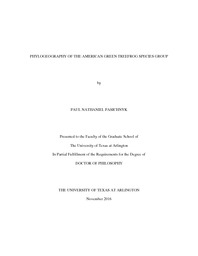
ATTENTION: The works hosted here are being migrated to a new repository that will consolidate resources, improve discoverability, and better show UTA's research impact on the global community. We will update authors as the migration progresses. Please see MavMatrix for more information.
Show simple item record
| dc.contributor.advisor | Campbell, Jonathan A. | |
| dc.contributor.advisor | Chippindale, Paul | |
| dc.creator | Pasichnyk, Paul Nathaniel | |
| dc.date.accessioned | 2017-02-14T16:22:26Z | |
| dc.date.available | 2017-02-14T16:22:26Z | |
| dc.date.created | 2016-12 | |
| dc.date.issued | 2016-12-08 | |
| dc.date.submitted | December 2016 | |
| dc.identifier.uri | http://hdl.handle.net/10106/26418 | |
| dc.description.abstract | The southeastern United States is an important temperate biodiversity hotspot, housing a multitude of endemic species and multiple large rivers fragmenting their ranges. To determine if the Riverine Barriers Hypothesis explains population divergence in this region, this study utilizes of a combination of phylogeographic methods and ecological niche modeling to investigate the role of rivers in genetic dispersal. Intra-and interspecific phylogenies for the hylid treefrogs Dryophytes cinereus, D. gratiosus and D. squirellus were estimated using nuclear and mitochondrial DNA sequences to identify relationships and genetic variation within these species and test for population structure, especially with respect to potential riverine barriers. Ecological niche models were then constructed to identify potential environmental factors affecting population structure. The results of the phylogeographic studies indicate that the Mississippi River could be a barrier to gene flow within D. cinereus; however, two samples from the western clade appeared on the eastern side of the river, indicating a limited gene exchange or colonization. Ecological niche models revealed little ecological niche variation between the two clades of D. cinereus which supports the presence of a geographic barrier to gene flow in a relatively homogeneous environment. However, the individuals belonging to clades associated with opposing sides of the river suggest that the river might not serve as an absolute barrier to dispersal. Evidence of hybridization between D. cinereus and D. gratiosus based on the phylogenies indicates that the ultimate cause of the variation in D. cinereus might not be entirely geographic. This study provides new insight into a long-debated question regarding the presence of reproductive character displacement in D. cinereus versus the possibility that intraspecific variation resulted from isolation during historic climate fluctuations, and it enlightens previous studies that indicate sex-biased hybridization in this group. | |
| dc.format.mimetype | application/pdf | |
| dc.language.iso | en_US | |
| dc.subject | Biodiversity | |
| dc.subject | Phylogeography | |
| dc.title | Phylogeography of the American Green Treefrog Species Group | |
| dc.type | Thesis | |
| dc.degree.department | Biology | |
| dc.degree.name | Doctor of Philosophy in Quantative Biology | |
| dc.date.updated | 2017-02-14T16:22:26Z | |
| thesis.degree.department | Biology | |
| thesis.degree.grantor | The University of Texas at Arlington | |
| thesis.degree.level | Doctoral | |
| thesis.degree.name | Doctor of Philosophy in Quantative Biology | |
| dc.type.material | text | |
| dc.creator.orcid | 0000-0003-1677-9779 | |
Files in this item
- Name:
- PASICHNYK-DISSERTATION-2016.pdf
- Size:
- 7.888Mb
- Format:
- PDF
This item appears in the following Collection(s)
Show simple item record


